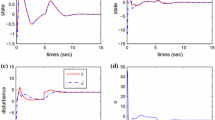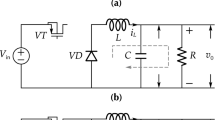Abstract
In this paper, a data-driven method for disturbance estimation and rejection is presented. The proposed approach is divided into two stages: an inner stabilization loop, to set the desired reference model, together with an outer loop for disturbance estimation and compensation. Inspired by the active disturbance rejection control framework, the exogenous and endogenous disturbances are lumped into a total disturbance signal. This signal is estimated using an on-line algorithm based on a data-driven predictor scheme, whose parameters are chosen to satisfy high robustness-performance criteria. The above process is presented as a novel enhancement to design a disturbance observer, which constitutes the main contribution of the paper. In addition, the control strategy is completely presented in discrete time, avoiding the use of discretization methods for its digital implementation. As a case study, the voltage control of a DC-DC synchronous buck converter affected by disturbances in the input voltage and the load is considered. Finally, experimental results that validate the proposed strategy and some comparisons with the classical disturbance observer-based control are presented.











Similar content being viewed by others
References
Han, J. (1995). Extended state observer for a class of uncertain plants. Control Decision, 10(1), 85–88 (in Chinese).
Han, J. (1998). Auto disturbances rejection controller and its applications. Control Decision, 13(1), 19–23 (in Chinese).
Han, J. (2009). From pid to active disturbance rejection control. IEEE Transactions on Industrial Electronics, 56(3), 900–906.
Huang, Y., & Xue, W. (2014). Active disturbance rejection control: Methodology and theoretical analysis. ISA Transactions, 53(4), 963–976.
Chen, W. H., Yang, J., Guo, L., & Li, S. (2016). Disturbance-observer-based control and related methods – an overview. IEEE Transactions on Industrial Electronics, 63(2), 1083–1095.
Gao, Z. (2006). Active disturbance rejection control: a paradigm shift in feedback control system design. In Proceedings of the American Control Conference. Minneapolis, MN, USA.
Radke, A., & Gao, Z. (2006). A survey of state and disturbance observers for practitioners. In Proceedings of the American Control Conference. Minneapolis, MN, USA.
Guo, B.-Z., & Zhao, Z.-L. (2016). Active Disturbance Rejection Control for Nonlinear Systems: An Introduction. Hoboken: Wiley.
Rojas-Cubides, H., Cortés-Romero, J., Coral-Enriquez, H., & Rojas-Cubides, H. (2019). Sliding mode control assisted by GPI observers for tracking tasks of a nonlinear multivariable Twin-Rotor aerodynamical system. Control Engineering Practice, 88, 1–15.
Arcos-Legarda, J., Cortes-Romero, J., & Tovar, A. (2016). Active disturbance rejection control based on generalized proportional integral observer to control a bipedal robot with five degrees of freedom. In Proceedings of the American Control Conference (pp. 3928–3933). Boston, MA, USA.
Hostetter, G. H., & Meditch, J. S. (1973). On the generalization of observers to systems with unmeasurable, unknown inputs. Automatica, 9(6), 721–724.
Khalil, H. K. (2017). High-gain Observers in Nonlinear Feedback Control. Society for Industrial and Applied Mathematics (SIAM).
Sariyildiz, E., Oboe, R., & Ohnishi, K. (2020). Disturbance observer-based robust control and its applications: 35th anniversary overview. IEEE Transactions on Industrial Electronics, 67(3), 2042–2053.
Chen, X., Zhai, G., & Fukuda, T. (2004). An approximate inverse system for nonminimum-phase systems and its application to disturbance observer. Systems & Control Letters, 52(3–4), 193–207.
Zheng, M., Lyu, X., Liang, X., & Zhang, F. (2021). A generalized design method for learning-based disturbance observer. IEEE/ASME Transactions on Mechatronics, 26(1), 45 – 54.
Bertoluzzo, M., Buja, G. S., & Stampacchia, E. (2004). Performance analysis of a high-bandwidth torque disturbance compensator. IEEE/ASME Transactions on Mechatronics, 9(4), 653–660.
Park, G, Joo, Y., Lee, C., & Shim, H. (2015). On robust stability of disturbance observer for sampled-data systems under fast sampling: An almost necessary and sufficient condition. In Proceedings of the IEEE Conference on Decision and Control (pp. 7536–7541). Osaka, Japan.
Kempf, C. J., & Kobayashi, S. (1999). Disturbance observer and feedforward design for a high-speed direct-drive positioning table. IEEE Transactions on Control Systems Technology, 7(5), 513–526.
Na, J., Costa-Castelló, R., Griñó, R., & Ren, X. (2012). Discrete-time repetitive controller for time-delay systems with disturbance observer. Asian Journal of Control, 14(5), 1340–1354.
Kwon, S. J., & Chung, W. K. (2003). A discrete-time design and analysis of perturbation observer for motion control applications. IEEE Transactions on Control Systems Technology, 11(3), 399–407.
Kim, W., Chen, X., Lee, Y., Chung, C. C., & Tomizuka, M. (2018). Discrete-time nonlinear damping backstepping control with observers for rejection of low and high frequency disturbances. Mechanical Systems and Signal Processing, 104, 436–448.
Lin, S. Y., Yen, J. Y., Chen, M. S., Chang, S. H., & Kao, C. Y. (2017). An Adaptive Unknown Periodic Input Observer for Discrete-Time LTI SISO Systems. IEEE Transactions on Automatic Control, 62(8), 4073–4079.
Yan, W., Pang, C. K., & Du, C. (2017). Disturbance observer-based multirate control for rejecting periodic disturbances to the Nyquist frequency and beyond. Automatica, 82, 49–58.
Tanaskovic, M., Fagiano, L., Novara, C., & Morari, M. (2017). Data-driven control of nonlinear systems: An on-line direct approach. Automatica, 75, 1–10.
She, J.-H., Fang, M., Ohyama, Y., Hashimoto, H., & Min, W. (2008). Improving disturbance-rejection performance based on an equivalent-input-disturbance approach. IEEE Transactions on Industrial Electronics, 55(1), 380–389.
Cortes-Romero, J., Arcos-Legarda, J., Ramos, G.A. (2015). An active disturbance rejection approach based on signal processing. In Proceedings of the 54th IEEE Conference on Decision and Control (CDC) (pp. 7530–7535). Osaka, Japan.
She, J.-H., Xin, X., & Pan, Y. (2010). Equivalent-input-disturbance approach analysis and application to disturbance rejection in dual-stage feed drive control system. IEEE/ASME Transactions on Mechatronics, 16(2), 330–340.
Kim, K.-S., Rew, K.-H., & Kim, S. (2010). Disturbance observer for estimating higher order disturbances in time series expansion. IEEE Transactions on Automatic Control, 55(8), 1905–1911.
Sun, J., & Li, S. (2017). Disturbance observer based iterative learning control method for a class of systems subject to mismatched disturbances. Transactions of the Institute of Measurement and Control, 39(11), 1749–1760.
Yu, S., & Tomizuka, M. (2009). Performance enhancement of iterative learning control system using disturbance observer. In IEEE/ASME International Conference on Advanced Intelligent Mechatronics (pp. 987–992). Singapore.
Chen, C.-T. (1995). Analog and Digital Control System Design: Transfer-function, State-space, and Agebraic Methods. Oxford: Oxford University Press Inc.
Chen, S., Xue, W., & Huang, Y. (2020). On active disturbance rejection control for nonlinear systems with multiple uncertainties and nonlinear measurement. International Journal of Robust and Nonlinear Control, 30(8), 3411–3435.
Li, S., Yang, J., Chen, W. H., & Chen, X. (2012). Generalized extended state observer based control for systems with mismatched uncertainties. IEEE Transactions on Industrial Electronics, 59(12), 4792–4802.
Sira-Ramírez, H. (2018). From flatness, GPI observers, GPI control and flat filters to observer-based ADRC. Control Theory and Technology, 16(4), 249–260.
Yang, H., Zhang, Y., Liang, J., Liu, J., Zhang, N., & Walker, P. D. (2018). Robust deadbeat predictive power control with a discrete-time disturbance observer for PWM rectifiers under unbalanced grid conditions. IEEE Transactions on Power Electronics, 34(1), 287–300.
Erickson, R. W., Maksimović, D. (2001). Fundamentals of Power Electronics. 2nd ed. Boston: Springer.
Wang, J., Li, S., Yang, J., Bin, W., & Li, Q. (2015). Extended state observer-based sliding mode control for PWM-based DC-DC buck power converter systems with mismatched disturbances. IET Control Theory and Applications, 9(4), 579–586.
Figueres, E., Garcerá, G., Benavent, J. M., Pascual, M., & Martínez, J. A. (2006). Adaptive two-loop voltage-mode control of DC-DC switching converters. IEEE Transactions on Industrial Electronics, 53(1), 239–253.
Zhang, C., Wang, J., Li, S., Bin, W., & Qian, C. (2015). Robust control for PWM-based DC-DC buck power converters with uncertainty via sampled-data output feedback. IEEE Transactions on Power Electronics, 30(1), 504–515.
Jelali, M. (2013). Control Performance Management in Industrial Automation: Assessment Diagnosis and Improvement of Control Loop Performance. 1st ed. London: Springer.
Author information
Authors and Affiliations
Corresponding author
Rights and permissions
About this article
Cite this article
Rojas-Cubides, H., Cortés-Romero, J. & Arcos-Legarda, J. Data-driven disturbance observer-based control: an active disturbance rejection approach. Control Theory Technol. 19, 80–93 (2021). https://doi.org/10.1007/s11768-021-00039-x
Received:
Revised:
Accepted:
Published:
Issue Date:
DOI: https://doi.org/10.1007/s11768-021-00039-x




